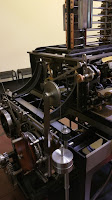As a teaser I include a few random bits of the museum that caught my attention (I may have been too engrossed in the rest of the museum to remember taking pictures).
One of the oldest "computers": Antikythera mechanism - had never heard of it before! The Ancient Greeks continue to impress! Shows another timeless quality of humanity: our technological innovations are consistently driven by our need for entertainment (in the case of the Ancient Greeks, such innovations can be linked back to scheduling the Olympic Games). At this museum, there was a full gallery devoted to old calculators and various mechanical computing implements from different cultures.
A fully-working constructed version of Babbage's Difference Engine - completed in 2008 according to Babbage's original designs (which apparently worked like a charm without any modification!) Museum workers crank this mechanical beast up a few times a day for the marvel of the crowd. Once set, this machine can compute logarithms, print them on a rolling receipt, and simultaneously stamp an imprint of the same values into a mold (for later reprinting!) Babbage also thought of what happens when the imprinting fills up the whole mold - a mechanical mechanism halts the whole process, so that the tablet can be replaced! That's some advanced UI, developed without any debugger or user studies.
Based on the over-representation of this Babbage Engine in this post, you can tell that quite a bit of time was spent gawking at it:
By the way, here's a real (previously functional) component from the Univac. Unlike that panel with lights and switches at the top of this post. Apparently, that did not do anything. It was purely for marketing purposes for whenever the then-investors came around to check out this "machine" - much more believable that something real is happening when you have dashboard blinking of some kind and large buttons that serve no purpose but look "very computational". Looks like this continues to be a powerful marketing strategy to this day :)
The following describes quite a few computer scientists I know:
There was a gallery devoted to Supercomputers and another gallery devoted to computer graphics. Look at what I found there - every Graphics PhD student's rite of passage (by the way, the Intrinsic Images dataset is sitting in my office, no glass case, but we will soon start charging chocolate to see it):
There was also a whole gallery devoted to robots and A.I. (an impressive collection), a gallery devoted to computer games, and a gallery devoted to the Apple computer just to name a few.
By the way, something I didn't know about the Apple computer - here is some awesome bit of marketing that came out in 1984:
There was a gallery devoted to the Google self-driving car. I like how this is in the Computer History museum, because really, you can't put any computer technology in a museum and assume it will remain current for very long. The drone in the corner of that room had a caption that mentioned something about possible future deliveries. Old news. I've seen bigger drones :)
That's about the extent of the photos I took, because photos really fail to convey the environment that a museum surrounds you with. It is a museum I would gladly recommend!
As an after-thought, it's interesting to visit a "history" museum where you recognize many of the artifacts. Gives you a sense of the timescale of technological innovation which continues to redefine what "history", "progression" and "timescale" really mean... notions that we have to regularly recalibrate to.










No comments:
Post a Comment